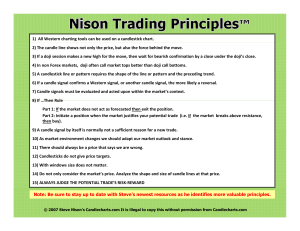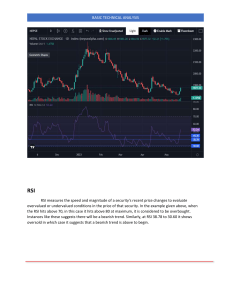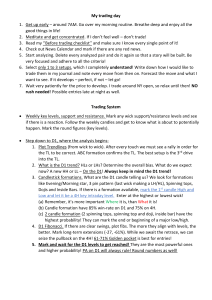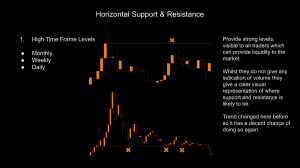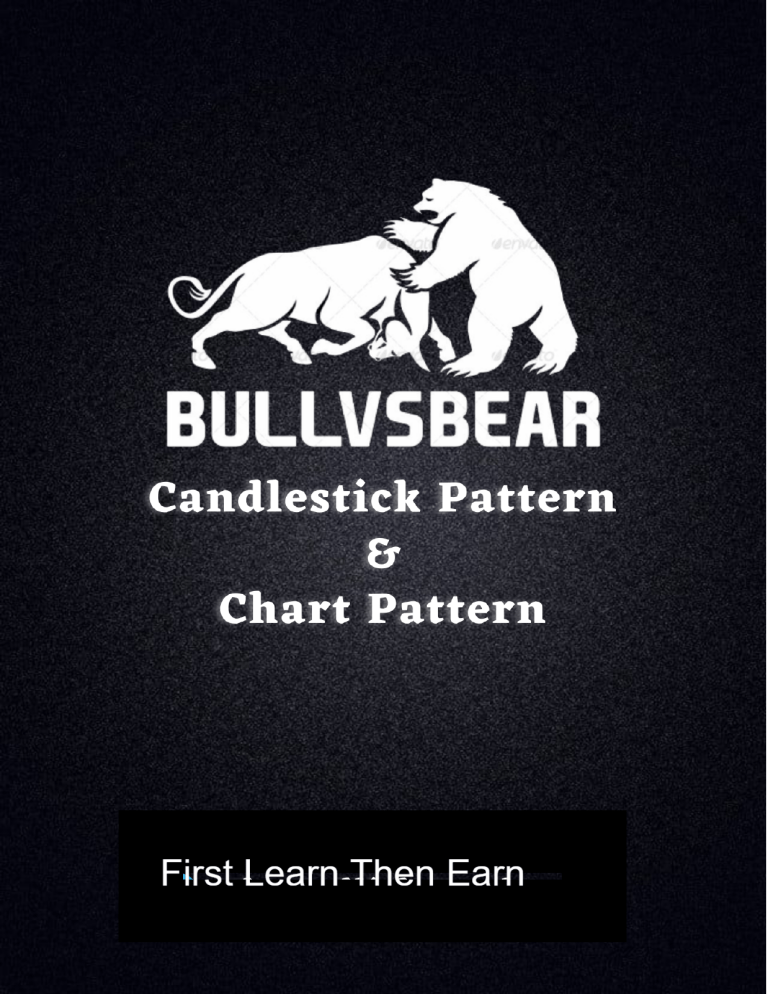
Three Line Strike A three-line strike is a continuation group of candlesticks that has three bars in the direction of a trend, followed by a final candle that pulls back to the start point. Morning Doji Star The Morning Doji Star candlestick formation is a three-day bullish reversal pattern. The Morning Doji Star candlestick pattern starts during a downtrend. The downtrend continues with a large-bodied candlestick. The second day opens lower, trades in a small range, then closes at its open forming a Doji. Evening Doji Star An Evening Doji Star consists of a long bullish candle, followed by a Doji that gaps up, then a third bearish candle that gaps down and closes well within the body of the first candle. An Evening Doji Star is a three candle bearish reversal pattern similar to the Evening Star. Confirmation Candlestick Pattern Three Inside Up The three inside up pattern is a bullish reversal pattern composed of a large down candle, a smaller up candle contained within the prior candle, and then another up candle that closes above the close of the second candle. Three Inside Down The three inside down pattern is a bearish reversal pattern composed of a large up candle, a smaller down candle contained within the prior candle, and then another down candle that closes below the close of the second candle. Three Outside Up The three outside up is a bullish candlestick pattern with the following characteristics: The market is in a downtrend. The first candle is black. The second candle is white with a long real body and fully contains the first candle. The third candle is white with a higher close than the second candle. Three Outside Down The three outside down, meanwhile, is a bearish candlestick pattern with the following characteristics: The market is in an uptrend. The first candle is white. The second candle is black with a long real body that fully contains the first candle. The third candle is black with a close lower than the second candle. the_bullish.trader The Bullish Trader Reversal Chart Pattern Double Top What Is a Double Top? A double top is an extremely bearish technical reversal pattern that forms after an asset reaches a high price two consecutive times with a moderate decline between the two highs. It is confirmed once the asset's price falls below a support level equal to the low between the two prior highs. Double Bottom The double bottom pattern is a bullish reversal pattern that occurs at the bottom of a downtrend and signals that the sellers, who were in control of the price action so far, are losing momentum. The pattern resembles the letter “W” due to the two-touched low and a change in the trend direction from a downtrend to an uptrend. Tripl Top The triple top pattern occurs when the price of an asset creates three peaks at nearly the same price level. The area of the peaks is resistance. The pullbacks between the peaks are called the swing lows. Tripl Bottom 1Bottom 2 Bottom 3 Bottom A triple bottom is a visual pattern that shows the buyers (bulls) taking control of the price action from the sellers (bears). A triple bottom is generally seen as three roughly equal lows bouncing off support followed by the price action breaching resistance. Head and Shoulders A head and shoulders pattern is a chart formation that appears as a baseline with three peaks, where the outside two are close in height and the middle is highest. In technical analysis, a head and shoulders pattern describes a specific chart formation that predicts a bullish-to-bearish trend reversal. Inverse Head and Shoulders An inverse head and shoulders pattern is comprised of three component parts: After long bearish trends, the price falls to a trough and subsequently rises to form a peak. The price falls again to form a second trough substantially below the initial low and rises yet again. Rising Wedge A rising wedge is a technical indicator, suggesting a reversal pattern frequently seen in bear markets. This pattern shows up in charts when the price moves upward with pivot highs and lows converging toward a single point known as the apex. When it is accompanied by declining volume, it can signal a trend reversal and a continuation of the bear market Falling Wedge The falling wedge pattern is characterized by a chart pattern which forms when the market makes lower lows and lower highs with a contracting range. When this pattern is found in a downward trend, it is considered a reversal pattern, as the contraction of the range indicates the downtrend is losing steam. the_bullish.trader The Bullish Trader Continuous Chart Pattern Bullish Rectangle Rectangles are continuation patterns that occur when a price pauses during a strong trend and temporarily bounces between two parallel levels before the trend continues. As with many chart patterns, there is a bullish and bearish version. Bearish Rectangle The bearish rectangle is a continuation pattern that occurs when a price pauses during a strong downtrend and temporarily bounces between two parallel levels before the trend continues. Bullish Pennant A bullish pennant is a technical trading pattern that indicates the impending continuation of a strong upward price move. They're formed when a market makes an extensive move higher, then pauses and consolidates between converging support and resistance lines. Bearish Pennant A bearish pennant is a technical trading pattern that indicates the impending continuation of a downward price move. They're essentially the opposite to bullish pennants: instead of consolidating after a move up, the market pauses on a significant move down. Bullish Flag Bullish flag formations are found in stocks with strong uptrends and are considered good continuation patterns. They are called bull flags because the pattern resembles a flag on a pole. The pole is the result of a vertical rise in a stock and the flag results from a period of consolidation. Bearish Flag The bearish flag is a candlestick chart pattern that signals the extension of the downtrend once the temporary pause is finished. As a continuation pattern, the bear flag helps sellers to push the price action further lower. Bullish Cup and Handle A cup and handle is considered a bullish signal extending an uptrend, and it is used to spot opportunities to go long. Technical traders using this indicator should place a stop buy order slightly above the upper trendline of the handle part of the pattern. Inverted Cup and Handle An 'inverted cup and handle' is a chart pattern that indicates bearish continuation, triggering a sell signal. Think of it as an upside-down cup and handle. If you look at the regular cup and handle pattern, there is a distinct 'u' shape and downward handle, which is followed by a bullish continuation. the_bullish.trader The Bullish Trader Neutral Chart Patterns Ascending Triangle An ascending triangle is a chart pattern used in technical analysis. It is created by price moves that allow for a horizontal line to be drawn along the swing highs and a rising trendline to be drawn along the swing lows. The two lines form a triangle. Traders often watch for breakouts from triangle patterns. Descending Triangle A descending triangle is a bearish chart pattern used in technical analysis that is created by drawing one trend line that connects a series of lower highs and a second horizontal trend line that connects a series of lows. Symmetrical Triangle A symmetrical triangle is a chart pattern characterized by two converging trend lines connecting a series of sequential peaks and troughs. These trend lines should be converging at a roughly equal slope. Symmetrical Expending Triangle A symmetrical triangle chart pattern represents a period of consolidation before the price is forced to breakout or breakdown. A breakdown from the lower trendline marks the start of a new bearish trend, while a breakout from the upper trendline indicates the start of a new bullish trend. Created by Shubham Patel


